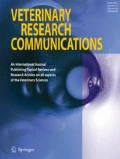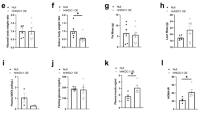Abstract
In most mammals, glucokinase (GK) acts as a hepatic “glucose sensor” that permits hepatic metabolism to respond appropriately to changes in plasma glucose concentrations. GK activity is potently regulated by the glucokinase regulatory protein (GKRP), which is encoded by the GCKR gene. GKRP binds GK in the nucleus and inhibits its activity. GK becomes active when it is released from GKRP and translocates to the cytosol. Low glucokinase (GK) activity is reported to be a principal feature of feline hepatic carbohydrate metabolism but the molecular pathways that regulate GK activity are not known. This study examined the hypothesis that species-specific differences in GKRP expression parallel the low GK activity observed in feline liver. Hepatic GKRP expression was examined using RT-PCR, immunoblot, and confocal immunomicroscopy. The results show that the GCKR gene is present in the feline genome but GCKR mRNA and the GKRP protein were absent in feline liver. The lack of GKRP expression in feline liver indicates that the low GK activity cannot be the result of GKRP-mediated inhibition of the GK enzyme. However, the absence of the permissive effects of GCKR expression on GK expression and activity may contribute to reduced GK enzyme activity in feline liver. The study results show that the cat is a natural model for GCKR knockout and may be useful to study regulation of GCKR expression and its role in hepatic glucose-sensing and carbohydrate metabolism.







Similar content being viewed by others
References
Agius L. The physiological role of glucokinase binding and translocation in hepatocytes. Adv Enzyme Regul. 38:303–31, 1998. doi:10.1016/S0065-2571(97)00001-0
Ballard FJ. Glucose utilization in mammalian liver. Comp Biochem Physiol. 14:437–43, 1965. doi:10.1016/0010-406X(65)90218-5
Chu CA, Fujimoto Y, Igawa K, Grimsby J, Grippo JF, Magnuson MA, Cherrington AD, and Shiota M. Rapid translocation of hepatic glucokinase in response to intraduodenal glucose infusion and changes in plasma glucose and insulin in conscious rats. Am J Physiol Gastrointest Liver Physiol. 2864:G627–34, 2004. doi:10.1152/ajpgi.00218.2003
de la Iglesia N, Mukhtar M, Seoane J, Guinovart JJ, and Agius L. The role of the regulatory protein of glucokinase in the glucose sensory mechanism of the hepatocyte. J Biol Chem. 27514:10597–603, 2000. doi:10.1074/jbc.275.14.10597
Farrelly D, Brown KS, Tieman A, Ren J, Lira SA, Hagan D, Gregg R, Mookhtiar KA, and Hariharan N. Mice mutant for glucokinase regulatory protein exhibit decreased liver glucokinase: a sequestration mechanism in metabolic regulation. Proc Natl Acad Sci U S A. 9625:14511–6, 1999. doi:10.1073/pnas.96.25.14511
Fernandez-Novell JM, Castel S, Bellido D, Ferrer JC, Vilaro S, and Guinovart JJ. Intracellular distribution of hepatic glucokinase and glucokinase regulatory protein during the fasted to refed transition in rats. FEBS Lett. 4592:211–4, 1999. doi:10.1016/S0014-5793(99)01249-1
Grimsby J, Coffey JW, Dvorozniak MT, Magram J, Li G, Matschinsky FM, Shiota C, Kaur S, Magnuson MA, and Grippo JF. Characterization of glucokinase regulatory protein-deficient mice. J Biol Chem. 27511:7826–31, 2000. doi:10.1074/jbc.275.11.7826
Li X, Li W, Wang H, Cao J, Maehashi K, Huang L, Bachmanov AA, Reed DR, Legrand-Defretin V, Beauchamp GK, and Brand JG. Pseudogenization of a Sweet-Receptor Gene Accounts for Cats’ Indifference toward Sugar. PLoS Genet. 11:e3, 2005. doi:10.1371/journal.pgen.0010003
Lindbloom S, LeCluyse M, Schermerhorn T. Cloning and comparative bioinformatic analysis of feline glucose-6-phosphatase catalytic subunit cDNA. DNA Sequence 193:256–263, 2008. doi:10.1080/10425170701574920
Pilkis SJ, Hansen RJ, and Krahl ME. Hexose-ATP phosphotransferases: comparative aspects. Comp Biochem Physiol. 253:903–12, 1968. doi:10.1016/0010-406X(68)90578-1
Postic C, Shiota M, Niswender KD, Jetton TL, Chen Y, Moates JM, Shelton KD, Lindner J, Cherrington AD, and Magnuson MA. Dual roles for glucokinase in glucose homeostasis as determined by liver and pancreatic beta cell-specific gene knock-outs using Cre recombinase. J Biol Chem. 2741:305–15, 1999. doi:10.1074/jbc.274.1.305
Postic C, Shiota M, and Magnuson MA. Cell-specific roles of glucokinase in glucose homeostasis. Recent Prog Horm Res. 56:195–217, 2001. doi:10.1210/rp.56.1.195
Printz RL and Granner DK. Tweaking the glucose sensor: adjusting glucokinase activity with activator compounds. Endocrinology 1469:3693–5, 2005. doi:10.1210/en.2005-0689
Rogers QR, Morris JG, and Freedland RA. Lack of hepatic enzymatic adaptation to low and high levels of dietary protein in the adult cat. Enzyme 225:348–56, 1977.
Schnell SA, Staines WA, and Wessendorf MW. Reduction of lipofuscin-like autofluorescence in fluorescently labeled tissue. J Histochem Cytochem. 476:719–30, 1999.
Shiota C, Coffey J, Grimsby J, Grippo JF, and Magnuson MA. Nuclear import of hepatic glucokinase depends upon glucokinase regulatory protein, whereas export is due to a nuclear export signal sequence in glucokinase. J Biol Chem. 27452:37125–30, 1999. doi:10.1074/jbc.274.52.37125
Tanaka A, Inoue A, Takeguchi A, Washizu T, Bonkobara M, and Arai T. Comparison of expression of glucokinase gene and activities of enzymes related to glucose metabolism in livers between dog and cat. Vet Res Commun. 296:477–85, 2005. doi:10.1007/s11259-005-1868-1
Tiedge M, Krug U, and Lenzen S. Modulation of human glucokinase intrinsic activity by SH reagents mirrors post-translational regulation of enzyme activity. Biochim Biophys Acta. 13372:175–90, 1997.
Vandercammen A, Van Schaftingen E. Species and tissue distribution of the regulatory protein of glucokinase. Biochem J. 294 Pt 2:551–6, 1993.
Washizu T, Tanaka A, Sako T, Washizu M, and Arai T. Comparison of the activities of enzymes related to glycolysis and gluconeogenesis in the liver of dogs and cats. Res Vet Sci. 672:205–6, 1999. doi:10.1053/rvsc.1998.0305
Wilson JE. Isozymes of mammalian hexokinase: structure, subcellular localization and metabolic function. J Exp Biol. 206Pt 12:2049–57, 2003. doi:10.1242/jeb.00241
Zoran DL. The carnivore connection to nutrition in cats. J Am Vet Med Assoc. 22111:1559–67, 2002, Dec 1.
Grants
Supported by the Morris Animal Foundation (TS) and the Winn Feline Foundation (TS).
Disclosures
No disclosures.
Author information
Authors and Affiliations
Corresponding author
Rights and permissions
About this article
Cite this article
Hiskett, E.K., Suwitheechon, Ou., Lindbloom-Hawley, S. et al. Lack of glucokinase regulatory protein expression may contribute to low glucokinase activity in feline liver. Vet Res Commun 33, 227–240 (2009). https://doi.org/10.1007/s11259-008-9171-6
Received:
Accepted:
Published:
Issue Date:
DOI: https://doi.org/10.1007/s11259-008-9171-6




